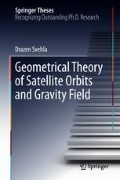Abstract
Here we present a novel SLR double-difference approach with GNSS satellites. It is shown how forming double-differences of SLR measurements between Herstmonceux (HERL) and Graz (GRZL) ILRS stations and two Galileo satellites removes common SLR biases: i.e., ILRS station range biases and common retro-reflector effects. By using the orbits of GNSS satellites from IGS as fixed in the parameter estimation, the double-difference SLR approach offers a bias-free estimation of relative coordinates with the mm-accuracy between two ILRS stations (SLR baseline) that are separated by about 5000 km. In this way, we obtain SLR observables of utmost precision and accuracy at sub-millimeter level with the standard deviation σ = 0.5 – 1.0 mm. We show that after differencing the remaining noise in the SLR measurements nicely averages out, leading to estimation of station coordinates, local ties between different space geodesy techniques and precise comparison of optical/microwave tropospheric effects. Considering that relative station coordinates between ILRS stations can be estimated in a similar way between collocated GNSS stations using the GNSS double-differences, the SLR approach allows direct estimation of local ties between SLR and GNSS ground stations. We extend the common-view SLR and make double-differences over time by considering the different observation times for all SLR measurements between all SLR stations. SLR range biases and small biases between SLR sessions are removed. The scale is preserved when double-differencing SLR and free of range biases (at mm-level), making this approach very attractive to combine ILRS network with IGS network in the global GNSS solution. We show that LLR offers estimation of UT0 and with differential SLR the global GNSS can estimate a complete terrestrial frame. For the un-differenced SLR we refer to Pearlman et al. (2002).
When a LEO satellite is observed by two SLR stations quasi-simultaneously with a GNSS satellite, one can calculate the “vertical SLR baseline” (vector) between the GNSS and the LAGEOS (LEO) satellite as well as the “vertical SLR range” (GNSS-LEO range) derived from geometry. This provides radial orbit information that can be used for altimetry and gravity field missions as well as reference frame satellites. At the end we extend the double-difference approach to other space geodesy techniques such as lunar laser ranging, VLBI and DORIS and discuss estimation of local ties and global reference frame parameters. We also derive a relationship between a possible bias in LAGEOS center of mass correction and radial bias in GNSS orbits. At the end we extend the concept of SLR double-differencing to lunar laser ranging (LLR) and present first results for the LLR double-difference baseline. We succeeded in processing LLR measurements to Apollo and Luna retro-reflectors on the Moon, and, in a similar way, have processed SLR measurements to GPS satellites considering only the geocentric frame in order to model the uplink and downlink for lunar laser ranges.
Access this chapter
Tax calculation will be finalised at checkout
Purchases are for personal use only
References
Bauersima I (1983) NAVSTAR global positioning system (GPS) I. Berne, Switzerland
Dedes GC, Mueller II (1989) Baseline estimation with semidynamic and geometric satellite methods. Bull Geodesique 63:99–114. https://doi.org/10.1007/BF02519145
Kouba J (2004) Improved relativistic transformations in GPS. GPS Solut 8:170–180. https://doi.org/10.1007/s10291-004-0102-x
Otsubo T, Appleby GM (2003) System-dependent center-of-mass correction for spherical geodetic satellites. J Geophys Res Solid Earth 108:n/a–n/a. https://doi.org/10.1029/2002jb002209
Otsubo T, Appleby G, Gibbs P (2001) GLONASS laser ranging accuracy with satellite signature effect. Surv Geophys 22:509–516
Pavlis EC (1985) On the geodetic applications of simultaneous range differences to LAGEOS. J Geophys Res 90:9431–9438. https://doi.org/10.1029/JB090iB11p09431
Pearlman MR, Degnan JJ, Bosworth JM (2002) The international laser ranging service. Adv Space Res 30:135–143. https://doi.org/10.1016/S0273-1177(02)00277-6
Petit G, Luzum B (2010) IERS Conventions. Verlag des Bundesamts für Kartographie und Geodäsie
Rummel R, Yi W, Stummer C (2011) GOCE gravitational gradiometry. J Geod 85:777–790. https://doi.org/10.1007/s00190-011-0500-0
Steigenberger P, Hugentobler U, Loyer S et al (2014) Galileo orbit and clock quality of the IGS Multi-GNSS experiment. Adv Space Res. https://doi.org/10.1016/j.asr.2014.06.030
Svehla D, Floberghagen R, Haagmans R et al (2012) SLR measurements of the forthcoming ESA Earth observation and fundamental physics missions and their applications in the reference frames realization. In: International technical laser workshop 2012, 5–9, 11 2012, Frascati, Italy, pp 1–2
Svehla D, Haagmans R, Floberghagen R et al (2013a) Geometrical SLR approach for reference frame determination - the first SLR double-difference baseline. In: IAG scientific assembly 2013, Potsdam, Germany, (reviewed for IAG Series 143). Springer
Svehla D, Rothacher M, Hugentobler U et al (2013b) STE-QUEST - space geodesy mission for celestial and terrestrial reference frame realization. In: STE-QUEST science workshop, ESTEC 22–23 May 2013. ESTEC/ESA, The Netherlands
Svehla D, Rothacher M, Appleby G et al (2014) High-accuracy double-difference slr approach with GNSS satellites for terrestrial reference frame realization. In: REFAG 2014, Luxembourg
Svehla D, Cacciapuoti L, Rothacher M (2015a) Noise model of the Galileo “mm-Clock” - geometrical mapping of the orbit perturbations using a clock on board Galileo satellites. In: IUGG general assembly 2015
Svehla D, Rothacher M, Appleby G et al (2015b) Double-difference SLR approach with GNSS, GEO, LAGEOS and LLR. In: IUGG general assembly 2015, Prague
Svehla D, Rothacher M, Cacciapuoti L (2016) Thermal re-radiation acceleration in the GNSS orbit modelling based on Galileo clock parameters. In: IGS workshop 2016, Sydney, Australia
Thaller D, Dach R, Seitz M et al (2011) Combination of GNSS and SLR observations using satellite co-locations. J Geod 85:257–272. https://doi.org/10.1007/s00190-010-0433-z
Williams GJ, Turyshev S et al (2009) Lunar science and lunar laser ranging. A white paper submitted to the Panel on Inner Planets – Mercury, Venus, and the Moon of The National Academies Planetary Science Decadal Survey, US
Author information
Authors and Affiliations
Corresponding author
Rights and permissions
Copyright information
© 2018 Springer International Publishing AG, part of Springer Nature
About this chapter
Cite this chapter
Svehla, D. (2018). The SLR/LLR Double-Difference Baseline. In: Geometrical Theory of Satellite Orbits and Gravity Field . Springer Theses. Springer, Cham. https://doi.org/10.1007/978-3-319-76873-1_17
Download citation
DOI: https://doi.org/10.1007/978-3-319-76873-1_17
Published:
Publisher Name: Springer, Cham
Print ISBN: 978-3-319-76872-4
Online ISBN: 978-3-319-76873-1
eBook Packages: Earth and Environmental ScienceEarth and Environmental Science (R0)

